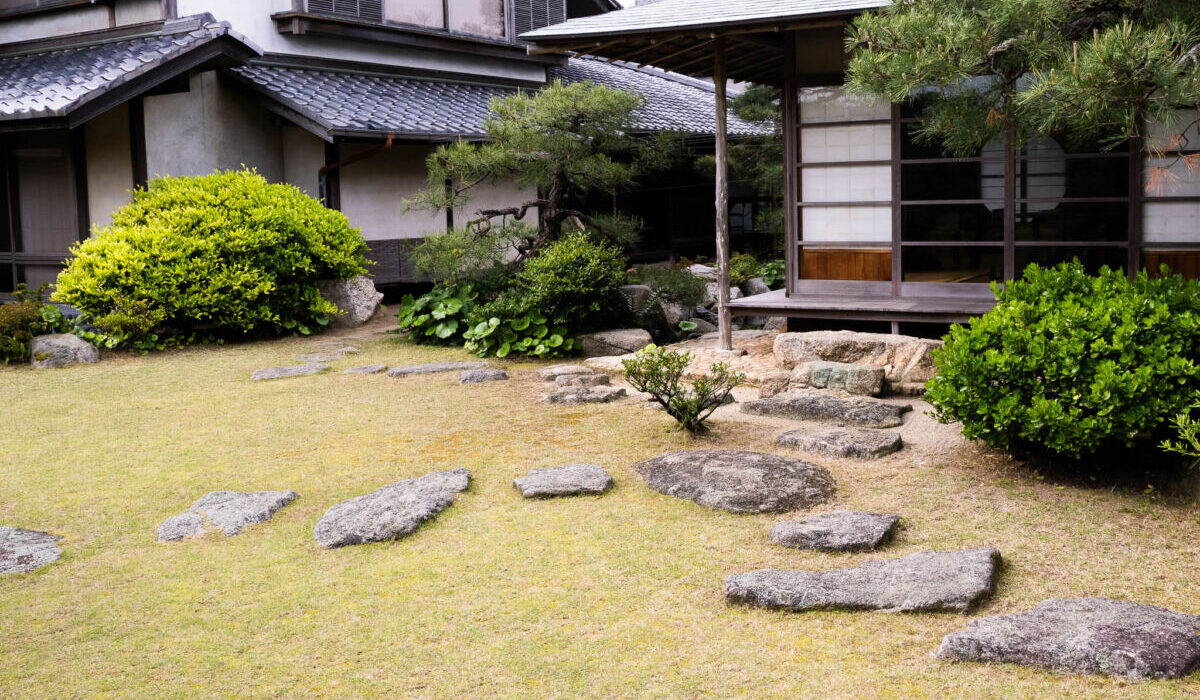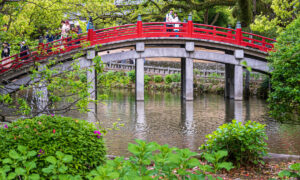
I believe staying in a traditional ryokan in Japan is the quintessential Japanese experience. It is one I’ve had twice and would thoroughly enjoy again.
I’ve read that ryokan (the traditional name of Japanese Inns) have had to change some to keep up with the times or satisfy the Western customer, but both overnights were terrific and gave me a brief glimpse into Japanese psyche. For example, adding a TV has been an adaptation.
Ryokan’s I’ve stayed in were built in traditional architecture—simple structures with shoji doors, wood floors and walls, glimpses of nature and minimal decor.
Let’s start with the entry.
You are greeted in the entry hall with bows and polite welcomes. Your shoes are whisked away to reappear when you depart and you are given slippers. These are for the halls and public rooms. More on that later. 
Your room is not like any Western hotel you’ve been in. The floors are covered with traditional tatami mats. There is a low table and cushions in the room. That’s it.
You are given a yukata to wear. A yukata is a cotton robe. I hope my travel mates will forgive me for including these photos but I do hope this conveys a bit of the experience. It was lovely not to have to think about clothes and to be so comfortable.
The Japanese value conformity and a sense of community. I believe these cultural norms are reflected in this tradition along with fact that it reduces the amount of stuff you need to bring with you. If you read last week’s blog post about trains you’ll understand.
Back to the slippers because to me they are endlessly fascinating.
You have separate slippers for in the room, but not on the tatami mats. You can wear socks on the tamtami mats. You are also required to change from the room slippers to toilet slippers when you go into the bathroom.
If you go out to walk in the garden, different slippers are positioned so that you can switch the indoor slippers when you want to go outside.
I’m told that children learn shoe etiquette in Japan at age four. There’s more to learn than what slippers to wear where. I noticed that whenever we went into a room where we wore slippers, our shoes were turned around to make exit easy. No messy piles allowed.
But what about a bed you might ask? Traditionally you would be served dinner in the room, but since I was on tours both times, we ate in our own special dining room with the group. While we were at dinner, the table was moved and bedding put down.
Lovely. Comfy. Not easy for someone with bad knees or hip problems, but we managed. We slept really well.

Connecting to the out-of-doors is an integral part of the experience. A ryokan is a place of peace and repose. Usually there is a garden or maybe a pond. Or both.
A big part of Japanese culture is the bath. The Ryokans we stayed in had communal baths, but also wooden tubs in our rooms. Talk about relaxing.
The Japanese have a special ritual about cleansing before entering the bath. I could do a whole blog post about that.
Some ryokans are centered on the Onsen experience or bathing in water from one of many hot springs in “The Land of Hot Springs” as Japan is sometimes called. I read where there are 3,000 Onsens (hot spring baths) in the country.
Washing with water as a form of purification is a central element of the Shinto religion—but that’s another blog post. In Japan, an Onsen experience is a recreational as well. Watch for a blog post mentioning the longest foot bath in the country. We soaked our weary feet in that one.
Many ryokans have been in the family for generations. At the Yoyokaku we loved meeting the original owner and her son who now runs the business.
The two ryokans we stayed in were Yoyokau Ryokan on the Cuisine and Culture trip organized by Espirit Travel and Asaba Ryokan on the Through an Artists Eyes by Tiny World Tours.
Heads Up
Susan will be giving a presentation at Olli at Aquinas College in Grand Rapids on November 30 at 9:30.
Join her on a journey to the Land of the Rising Sun where she will share photography from three multi week trips to Japan over the last four years.
Experience the Cherry Blossom festival, the bullet trains, interesting art focused venues, Buddhist Temples, Shinto Shrines and both Atomic Bomb sites along with a plethora of other items and experiences around this exotic destination.


















Comments
4 CommentsSusan Massaro McFarland
Aug 7, 2023Fascinating story about your trip to Japan. I enjoyed all the detail you included. Thank you for opening our eyes to how things are done in other parts of the world. Many of your posts do just that which is a huge accomplishment. By sharing your travel stories, those of us who don’t, or can’t travel as you do, get the benefit of your amazing stories.
Susan J. Smith
Aug 7, 2023Thank you so much, Susan. What a lovely comment. I am so glad you enjoy my efforts to connect people to places.
JoAnne Tompkins
Aug 7, 2023What a fascinating post! I love that everyone, regardless of gender, wears the same style garment. There is something so soothing about the setting and the slippers and the outlook onto water and nature. Thank you for posting this. It makes me want to venture to Japan.
Susan J. Smith
Aug 7, 2023We have stayed in hotels in Japan where they provide the yakatas and everyone wears them to dinner. Sometimes the men and women have different colors although I think it is more about size than gender.